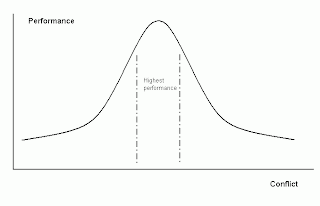Conflict is a part of life. There are conflicts of needs, wants, preferences, interests, opinions, beliefs and values. Conflicts are rooted in the way we are created: the diversity of human beings… So conflict is not avoidable.
Conflict is not necessarily bad. Conflicts can be productive, creating deeper understanding and respect, or they can be destructive and harmful. How the conflicts get resolved is the critical factor in determining whether a relationship will be healthy or unhealthy.
Actually conflict is necessary to get high performance; the absence of conflict is a strong indication of a problem and will degenerate into low performance. Fig.1 shows the relation between conflict and performance. The figure shows that too many conflicts and few conflicts decrease performance severely, but moderate amount of conflicts increases performance significantly.
Sometimes we intentionally create conflict for better performance, as example, the conflict between software developers and software quality assurance. While the development team focuses on finishing the project and closing issues, the quality team is focusing on finding defects in the processes and products. The success of the quality team is to find the largest number of defects which conflicts with the project manager and programmers task as they are focusing on closing issues and finishing the product. This is a very good example of creating conflict for better performance.
In teams, conflict almost exists at all levels, as example between the customer and the software development team, between the project manager and quality manager, between testers and programmers, between employer and the employees, between investor and the community, and between sales and development. These conflicts are not necessarily bad. The team should manage these conflicts for better understanding and agreements to let everyone win. Following is a step for healthy conflict resolution.
Healthy Conflict Resolution:
- Identify the problem or issues: Have a discussion to understand both views of the problem, conflicts, needs and preferred outcomes. Clarify to each other exactly what the conflict or problem involves. Here are some hints:
- Listening and not interrupting in order to be able to hear one another’s concerns.
- Summarizing what you have heard to be sure that concerns have been clearly conveyed.
- Focusing on the problem and not the person. Maintaining respect for the individual while acknowledging disparate points of view will open the door to a considered resolution.
- Use “I…” statements: This helps you be perceived as expressing yourself so that you are heard and understood, and makes other person more aware of your needs
- Avoid “YOU…” statements: They come across as attacking which creates defensiveness and counter attack and make the other person more focused on protecting themselves.
- Generate several possible solutions: Use creative and integrative approach, both parties think creatively about several possible solutions without evaluating them. List all possible solution weather one of the parties agrees on or not.
- Evaluate the alternative solutions: Narrow down the list to the solution that is accepted to both of you and meets the project objectives and the organization policy and other constraints.
- Consensus on the best solution: Consensus is the keyword here, both parties try to agree on a solution, if there’s no way to agree on a solution, the issue can be escalated to the next level of management for judgment.
- Follow-up: Follow up to be sure the application of the solution produces the expected results, in case of deviation, changes can be made to the solution, but sure any changes should also be agreed on or escalated.
As a conclusion, conflict is not necessarily bad, moderate conflict and healthy conflict resolution is important to achieve the highest possible performance and quality.
